Review for Sweet Bean (aka 'an') (2015) (Masters of Cinema) Dual Format
Introduction
I still get the occasional unsolicited disc dropping through the letterbox for review, which often turns out to be a nightmare of unwanted optical media. But on occasion I can be surprised by a release that didn’t initially appeal to me with the PR blurb, but turns out to be a magical piece of cinema. Sweet Bean is one such disc. It’s also an example of unrealistic expectations on my part, as while my eyes may have skipped past the initial e-mail, on second acquaintance, I merely gave the blurb a quick scan, and picked up on an old lady with ‘an extraordinary gift when it comes to making "an" - the sweet red bean paste filling’. I thought to myself that this would be the Japanese equivalent of Chocolat, and settled myself in for two hours of romantic whimsy. Sweet Bean is not Chocolat.
Sentaro runs a doroyaki concession, a small shop that specialises in small pancakes filled with sweet azuki bean paste. Specialises is too strong a word, as while he makes the pancakes, he uses generic filling that he orders in, and he’s not the most outgoing of vendors. Still, he’s doing well enough to put an ad in the shop for an employee to assist him. He isn’t expecting 76-year-old Tokue to apply for the job. The elderly woman with crippled hands is an unlikely assistant, but she perseveres, especially when she presents Sentaro with her homemade ‘an’, a world away from the mass market stuff. It isn’t long before there’s a crowd waiting outside the shop every morning in anticipation for fresh doroyaki, and Sentaro even begins to enjoy the work. But Tokue has a secret, and she isn’t the only one.
The Disc
Sweet Bean gets a 2.35:1 widescreen 1080p transfer with DTS-HD MA 5.1 and PCM 2.0 Stereo Japanese audio along with optional English subtitles. The transfer seems fine enough, no issues with compression or banding to my eyes, although I did have a few questions about the source material. Sweet Bean looks to be a digitally shot film, and it tends to look a little flat, colours a little faded, a little over-exposed, with contrast in darker scenes an issue. The question is whether it’s a deliberate choice, as it seems more evident in this film than most low-budget digital productions. There are moments in the film where the overexposed, washed out look takes on a magical, slightly unreal feel, making me suspect that it is indeed deliberate. The audio is fine, the surround used mostly for ambience, the dialogue clear throughout, and the mellow, understated piano music is sparsely, but effectively used. The subtitles are accurately timed and free of typographical error.
The images in this review were kindly supplied by Eureka Entertainment.
Extras
The disc boots straight to the main menu. As usual, there is a booklet with the release. In it you'll find an in-depth essay from Philip Kemp looking at the film, and at the director's life and career. There is also a statement from Naomi Kawase, and a brief text interview as well. As always with Masters of Cinema booklets, it's an essential accompaniment to the film.
On the disc, you’ll find the trailer for the film (1:42), and more importantly an Exclusive Interview with director Naomi Kawase, filmed in her home town of Nara this year. This lasts 35:25 and is presented in HD. It’s an interesting conversation, as she talks about the film, and her influences.
Conclusion
The paranoid might think that there is a conspiracy against independent film in Japan. There’s less and less of it being made, funding is harder to find, and all the multiplex space, and studio effort is going on the comic book blockbusters. Actually, that seems to be a universal problem, not just a Japanese one, but people are finding more and more creative ways to get around the issue. Niche Asian film distributor Third Window Films are moving into production themselves, finding it harder to come by independent content. Sweet Bean on the other hand is a multi-national co-production, with Japanese, German, and French investment behind it. Thankfully people are still willing to make, and more importantly watch independent cinema like this, as Sweet Bean really is quite special.
Just like its soundtrack, Sweet Bean is a mellow, contemplative movie, one in tune with the flow of life, savouring the moment, and finding pleasure and meaning in the small things. I never would have thought that the preparation of food would make for great cinema, but here you can watch these characters go about their work and appreciate their attention to detail, the act of culinary creation. At first, Sentaro may not be the most gregarious of chefs, and even while he’s grumping at his teenage customers, but he still takes pride in the doroyaki pancakes that he makes. When Tokue starts working with him, and shows him how to make ‘an’ from scratch, rather than buying generic, Sentaro initially balks at the process, but he soon learns just how rewarding it is to do it the traditional way, even if it means waking up before dawn.
There’s a wonderful sense of time in Sweet Bean, the passage of the day, working from dawn to dusk, and also the passage of the seasons, following the year that Tokue and Sentaro work together. While the film may have a suburban setting, a small shop in a residential area, there is still a strong sense of nature, images of trees and the world in general, changing as the year turns from spring to summer, to autumn and beyond. It’s an aesthetically soothing film that justifies its slower, meditative pace.
For all this, Sweet Bean is actually all about outcasts. Tokue’s suffered from a debilitating condition that has left her ostracised for much of her life, and her desire to work in the concession is practically her first attempt to rejoin society. It’s almost heart-breaking to see her try and negotiate the meagre pay down to the level where Sentaro will hire her. Things work out well at first, until the rumours begin to fly, and the truth about Tokue is revealed. In contrast to that earlier moment, one of the most uplifting points of the film is when Sentaro chooses to ignore the rumours, and keep working with Tokue.
The reason for his sympathy becomes clear when his past is revealed, that he’s another outsider who is beholden to his landlady, because of a mistake he made, and which also explains his initial lack of enthusiasm at his work. Then there is Wakana, a regular customer who is a middle school girl, and a more traditional outsider. She doesn’t fit in with the other school girls, she has an awkward home life, she’s quiet and introverted, and it’s understandable why she’s drawn to Sentaro and Tokue, also outsiders. Through their cross-generational friendship, the three heal and rehabilitate each other, Wakana finding friends, Tokue engaging with society, and Sentaro finding his enthusiasm for his work.
Sweet Bean is a beautiful, understated film, which draws you in with its mesmerising imagery, and subtly provokes thought with its subject matter. It’s very much worth watching.
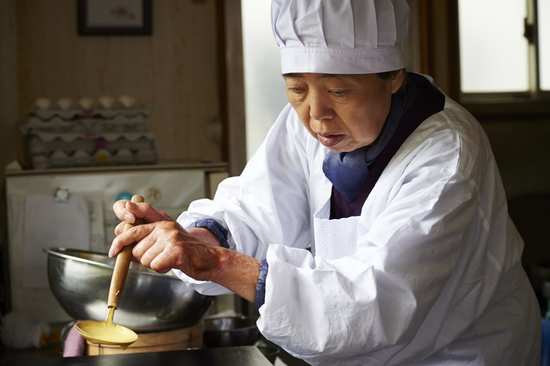
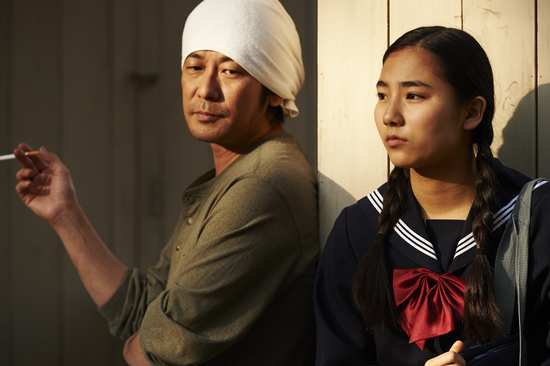
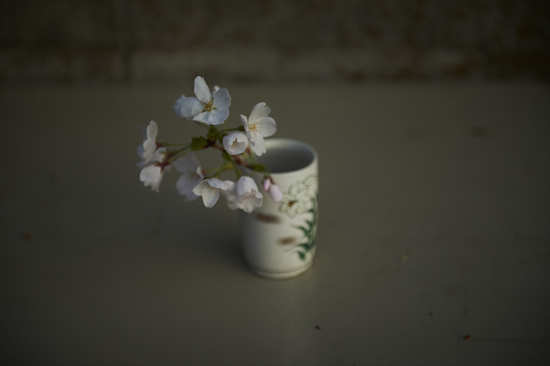

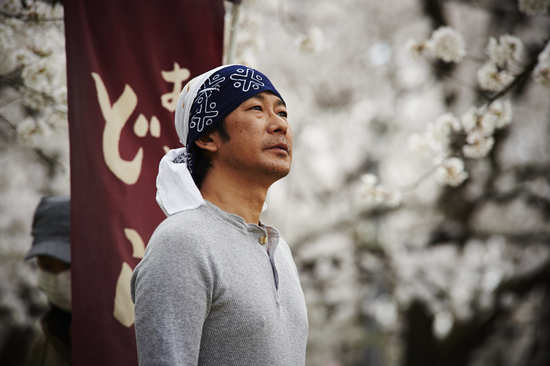
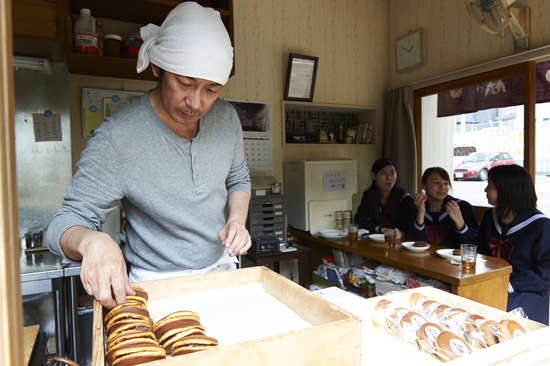
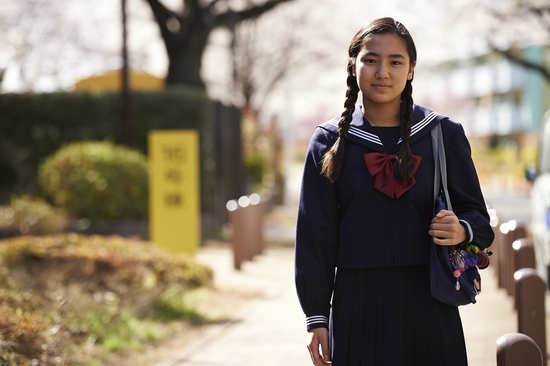

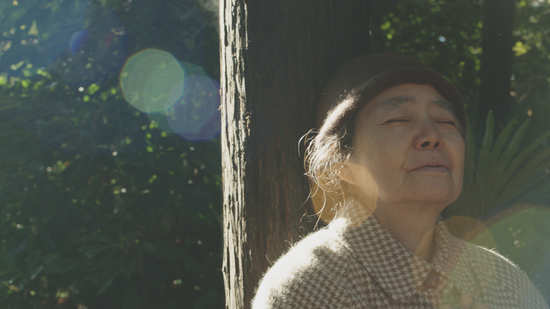
Your Opinions and Comments
Be the first to post a comment!